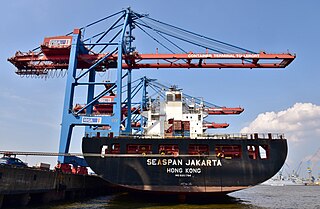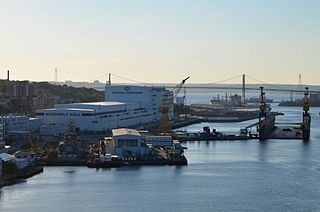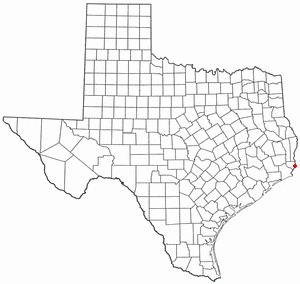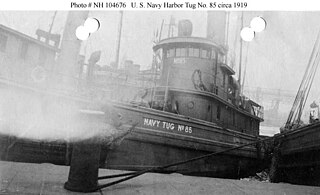
Newport News Shipbuilding (NNS), a division of Huntington Ingalls Industries, is the largest industrial employer in Virginia, and sole designer, builder and refueler of United States Navy aircraft carriers and one of two providers of U.S. Navy submarines. Founded as the Chesapeake Dry Dock and Construction Co. in 1886, Newport News Shipbuilding has built more than 800 ships, including both naval and commercial ships. Located in the city of Newport News, its facilities span more than 550 acres (2.2 km2), strategically positioned in one of the great harbors of the East Coast.

USS Algonquin, completed as El Toro in 1891 for the Southern Pacific Railroad's Morgan Line, was a small harbor tug commissioned by the United States Navy 2 April 1898. Renamed Accomac, after Accomac, Virginia, June 1898, renamed Nottoway in 1918 and, after the Navy adopted alphanumeric hull numbers on 17 July 1920, classified as YT-18, a district tug. On 5 October 1942 the name was cancelled and the tug was simply YT-18 until 1944 when classification was changed to YTL-18, a little harbor tug. Over the years as a Navy tug, from 1898 to 1946, the tug served from Cuba to Boston.

W. & A. Fletcher Co. was an American manufacturer of marine boilers and steam engines for steamboats on the Hudson, in the Great Lakes, Long Island Sound, and elsewhere in the late 19th and early 20th centuries. The company was founded in 1853 and associated with development of steam powered ships from the original crude efforts.

Seaspan ULC provides marine-related services to the Pacific Northwest. Within the Group are three shipyards, an intermodal ferry and car float business, and also a tug and barge transportation company that serves both domestic and international markets. Seaspan is part of the Washington Companies, owned by Dennis Washington. Seaspan is run by his son Kyle Washington, as Executive Chairman, who has become a Canadian citizen. Seaspan ULC was formerly known as Seaspan Marine Corporation, and prior to that Washington Marine Group.

The Halifax Shipyard Limited is a Canadian shipbuilding company located in Halifax, Nova Scotia.
The Santa Fe Railroad tugboats were used by the Atchison, Topeka and Santa Fe Railway to barge rail cars across the San Francisco Bay for much of the 20th century, as there is no direct rail link to the San Francisco peninsula. In the post World War II period, a fleet of three tugs moved the barges: the Paul P. Hastings, the Edward J. Engel, and the John R. Hayden. After cross-bay float service had ended and the tugs had been sold, the Hastings sank off Point Arena, California in 1992, in water too deep to raise. The Engel sank off Alameda, California in 2007 and was raised and scrapped in the winter of 2013-14. The Hayden remains afloat and in service in Oregon.

Luna is a historic tugboat normally berthed in Boston Harbor, Massachusetts. Luna was designed in 1930 by John G. Alden and built by M.M. Davis and Bethlehem Steel. She is listed on the National Register of Historic Places and is a U.S. National Historic Landmark. In 1985, the Luna was designated as a Boston Landmark by the Boston Landmarks Commission.

The Glen-class tugs were a class of tugboats of the Royal Canadian Navy built during the Second World War. There were three designs of the tugboat; two were of steel-hulled construction and the other was wooden-hulled. Of the 20 of the class built, 16 were of the steel-hulled type; 11 built by Russel Bros. of Owen Sound, Ontario and 5 by Canadian Dredge & Dock Co., Kingston, Ontario. Of the four wooden-hulled type; three were built by McKenzie Barge and Derrick, Vancouver, British Columbia, and one by LeBlanc Shipbuilding, Weymouth, Nova Scotia. All but one – Glendyne – were sold into commercial service after the war.

Standard Oil Company No. 16, later Pegasus, was a historic harbor tugboat located at Morris Canal Basin, Jersey City, New Jersey. She was built in 1907 by the Skinner Shipbuilding and Dry Dock Company of Baltimore, Maryland for the Standard Oil Company. She had heavy steel frames and deck beams. She was 100 feet in length, 23 feet in beam and 11.2 feet in depth. She was registered at 175 gross tons. She had an original wooden pilot house and the engine room dated to 1953-1954 when converted from steam to diesel. At that time, Standard Oil sold the tug to the McAllister Towing and Transportation Company and she was renamed McAllister 41. In 1955, she was renamed John E. McAllister.

Levingston Shipbuilding Company was a shipbuilding company at Orange, Texas on the Sabine River founded by George Levingston. During World War II Levingston Shipbuilding Company built ships for the United States Naval Station Orange also on the Sabine River]. George Levingston also purchased major shares of Joseph Weaver and Son Shipyard, also on the Sabine River. The company was started by Samuel H. Levingston in 1859.

Huntington was a historic tugboat, built in 1933 by the Newport News Shipbuilding and Dry Dock Company, Newport News, Virginia. She had a steel plate hull and a two-story superstructure that contained the main saloon, two cabins, heads and a galley on the lower level and wheelhouse and captains quarters on the upper level. The original coal fired steam engine was replaced by a diesel engine in 1950. The ship is named for shipyard founder Collis Potter Huntington (1821-1900). Huntington was retired from service at Newport News Shipbuilding and Dry Dock Company in 1992, then retired finally in 1994. The ship later served as floating museum, before being scrapped in 2010.

Bay Shipbuilding Company (BSC) is a shipyard and dry dock company in Sturgeon Bay, Door County, Wisconsin. As of 2015, Bay Ships was a subsidiary of Fincantieri Marine Group and produces articulated tug and barges, OPA-90 compliant double hull tank ships and offshore support vessels. It also provides repair services to the lake freighter fleet. In the past the shipyard located in Sturgeon Bay has operated under several different names and traces its history back to 1918.

The Type V ship is a United States Maritime Commission (MARCOM) designation for World War II tugboats. Type V was used in World War II, Korean War and the Vietnam War. Type V ships were used to move ships and barges. Type V tugboats were made of either steel or wood hulls. There were four types of tugboats ordered for World War II. The largest type V design was the sea worthy 186-foot (57 m) long steel hull, V4-M-A1. The V4-M-A1 design was used by a number of manufacturers; a total of 49 were built. A smaller steel hull tugboat was the 94-foot (29 m) V2-ME-A1; 26 were built. The largest wooden hull was the 148-foot (45 m) V3-S-AH2, of which 14 were built. The smaller wooden hull was the 58-foot (18 m) V2-M-AL1, which 35 were built. Most V2-M-AL1 tugboats were sent to England for the war efforts under the lend-lease act. The Type V tugs served across the globe during World War II including: Pacific War, European theatre and in the United States. SS Farallon and other Type V tugs were used to help built Normandy ports, including Mulberry harbour, on D-Day, June 6, 1944 and made nine round trips to Normandy to deliver Phoenix breakwaters.

USS AFDM-2,, is an AFDM-3-class medium auxiliary floating drydock built in Mobile, Alabama by the Alabama Drydock and Shipbuilding Company for the U.S. Navy. Originally named USS YFD-4, Yard Floating Dock-4, she operated by Todd Shipyards at New Orleans, Louisiana for the repair of US ships during World War II. YFD-4 was renamed an Auxiliary Floating Dock Medium AFDM-2 in 1945 after the war.

Victory Shipbuilding was a shipbuilding company in Newport Beach, California. To support the World War 2 demand for ships Victory Shipbuilding built: Tugboats and two sub chasers. Victory Shipbuilding opened in 1943. After World War 2, the shipyard closed. The shipyard was located at 613 Pacific Coast Hwy, Newport Beach. This was one of the few shipyards not on the waterfront.

Ackerman Boat Company was a wooden shipbuilding company in Newport Beach, California. Ackerman Boat Company built small barges in Newport Harbor working with Star D Iron Works, in Santa Ana. To support the World War 2 demand for ships Ackerman Boat Company shipyard switched over to military construction and built: US Army Harbor Tugboats and US Navy Landing Craft Mechanized Model LCM Mark 3. Clarence Ackerman started the Ackerman Boat Company was in 1943. Ackerman Boat Company worked with Consolidated Steel's Wilmington shipyard to build the Tugboat and Landing Craft. Near the end of the war, Ackerman sold the yard to Consolidated Steel but purchased it back in 1947. Ackerman sold the shipyard in 1958. The shipyard was at 151 Shipyard Way, Newport Beach on the Lido Peninsula at the corner of Rhine Place. The current site has been the Newport Harbor Shipyard since 1981, which repairs and restoration of yachts.

Eureka Shipbuilding was a wooden shipbuilding company in Eureka, California. The shipyard was just south of town in Fields Landing on the South Bay of Humboldt Bay. To support the World War 2 demand for ships Eureka Shipbuilding shipyard switched over to military construction and built: United States Marine Corps tugboatss. Eureka Shipbuilding was started in 1941. On January 25, 1943 Eureka Ship Builders, Inc. was awarded a contract to build six V2-M-AL1 tugboats at a cost of $35,970 each, contact number DA-MCc-824. V2-M-AL1 tus is a class of Type V ship. The V2-M-AL1 is also called a Port Sewall class tug. V2-V2-M-AL1 tugs were named for American ports. All of Eureka Shipbuilding tug were used for Lend-Lease use to Britain as type TUSA tugs. Afte the war in 1947 the company was renamed `

Bethlehem Key Highway Shipyard started as William Skinner & Sons in downtown Baltimore, Maryland in 1815. In 1899 the shipyard was renamed Skinner Shipbuilding & Dry Dock Company. Also at the site was Malster & Reanie started in 1870 by William T. Malster (1843–1907). In 1879 Malster partnered with William B. Reaney (1808-1883). In 1880 Malster & Reanie was sold and renamed Columbian Iron Works & Dry Dock Company. Malster & Reanie and Skinner Shipbuilding & Dry Dock Company merged in 1906, but remained as Skinner Shipbuilding. In 1914 the company was renamed Baltimore Dry Dock & Shipbuilding Company. Baltimore Dry Dock & Shipbuilding Company sold to Bethlehem Steel in 1922, becoming part of Bethlehem Shipbuilding Corporation. Bethlehem Steel operated the shipyard for ship repair, conversion and some ship construction. Bethlehem main ship construction site was across the harbor at Bethlehem Sparrows Point. Bethlehem Key Highway Shipyard was known as the Bethlehem Upper Yard located north-east side of Federal Hill. Bethlehem Fort McHenry Shipyard located on the west side of Locust Point peninsula was known as the Lower Yard, near Fort McHenry.

The YT-46-class harbor tugboat was a wood-hulled tugboat design ordered by the U.S. Navy in May and June 1918 during World War I. 40 ships of the type were launched and completed at 13 shipyards: the Charleston Navy Yard; the New Orleans Naval Yard; the Clayton Ship & Boat Building Company, Clayton, New York; the Eastern Shipyard Company, Greenport, New York; the Eastern Shore Shipbuilding Company, Sharpstown, Maryland; the Greenport Basin and Construction Company, Greenport, New York; the Hiltebrant Dry Dock Company, Kingston, New York; Robert Jacob Shipyard, City Island, New York; the Luders Marine Construction Company, Stamford, Connecticut; the Mathis Yacht Building Company, Camden, New Jersey; the New York Yacht, Launch & Engine Company, Bronx, New York; the Vinyard Shipbuilding Company, Milford, Delaware; and the Wheeler Shipyard Corporation, Brooklyn, New York. In 1920, at the Navy's adoption of alpha-numeric hull designations, the ships were classified as yard tugs YT-46 though YT-85.
The YT-86-class harbor tugboat was a wood-hulled tugboat design ordered by the U.S. Navy during World War I. 15 ships of the type were launched and completed, 12 as harbor tugs and three as ambulance boats. All were launched at the Mare Island Naval Shipyard in Vallejo, California except for one at the Pearl Harbor Naval Shipyard in Hawaii. In 1920, after the Navy's adoption of alpha-numeric hull designations, the ships were classified as yard tugs YT-86 though YT-90 and YT-92 through YT-99 and ambulance boats YH-1, YH-2, and YH-3.

















